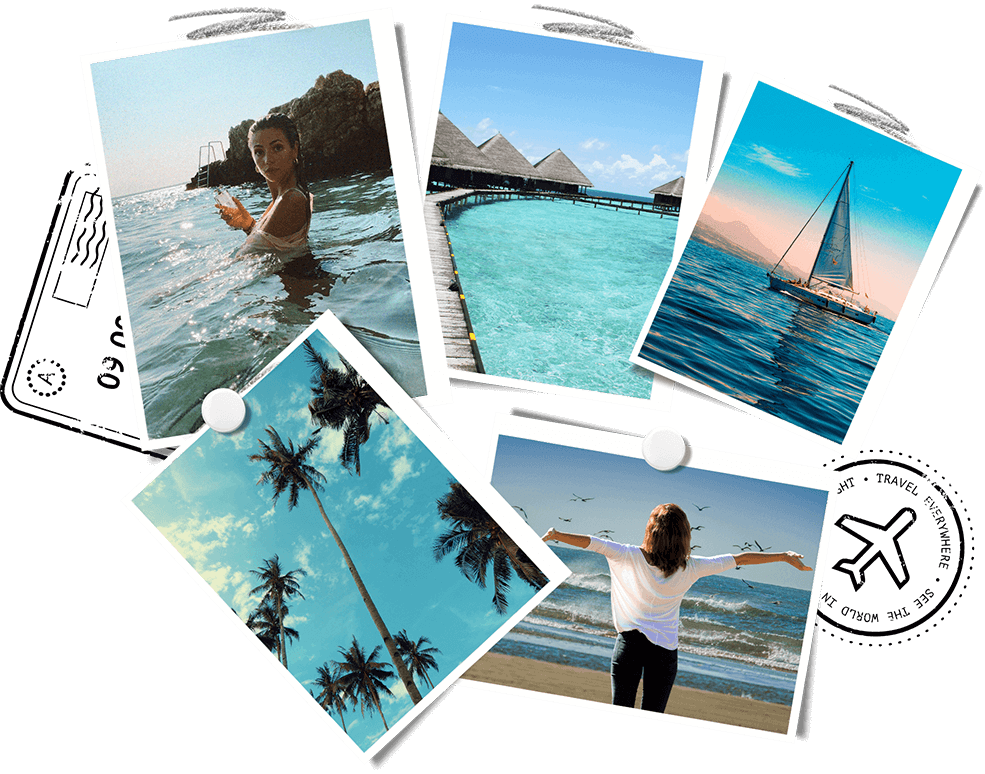Stop overpaying. Use our search tool to reveal unpublished fares and bonus onboard credit.
We recognize that Hawaii vacations are not just an investment, but often the highlights of our lives, and we take that responsibility seriously. We want to ensure you have the best vacation experience. Interested in a job in travel? Click here to learn: How to Become a Hawaii Travel Agent
Welcome to the beautiful beaches of Hawaii, where crystal-clear waters and stunning landscapes await. However, to ensure your beach experience is both enjoyable and safe, it's crucial to understand the ocean conditions and the warning flag system in place.
Know Your Limits: Before you dive into the ocean, it's essential to be aware of your health limits and fitness level. Always assess whether the conditions are suitable for your swimming abilities. Swimming at a lifeguarded beach is highly recommended, as lifeguards can provide immediate assistance and valuable insights into the current ocean conditions.
Beach Warning Flags are a vital part of ensuring your safety. These flags are used universally to indicate the safety of the water conditions. Here’s a brief overview of what each flag means:
| Flag Color | Meaning |
|---|---|
| Green Flag | Low hazard - Safe to swim and engage in water activities. |
| Yellow Flag | Medium hazard - Moderate surf and/or currents. Exercise caution. |
| Single Red Flag | High hazard - High surf and/or strong currents. Swimming not recommended. |
| Double Red Flags | Very dangerous - Water is closed to public use. |
| Purple Flag | Dangerous marine life has been spotted. Swim at your own risk. |
| Red and Yellow Flag | Recommended swimming area with lifeguard supervision. |
| Black and White Quartered Flag | Surfing area - Swimming not allowed. |
| Yellow Flag with a Black Ball | No surfboards and other non-powered watercraft are allowed. |
| Orange Windsock Flag | Offshore winds are present - Inflatables should not be used. |
| Red and White Flag | Emergency evacuation - Leave the water immediately. |
Understanding these flags is just the beginning. Always read and obey posted warning signs and be aware of the ocean conditions. Never turn your back on the ocean, and always enter the water gradually and watchfully. Note the locations of rocks, breakers, currents, and reefs before entering the water. If in doubt, it's best to stay out.
Additionally, swim with a buddy at the beach and ensure that you are supervised by lifeguards. This can significantly enhance your safety and allow for a more enjoyable beach experience. Remember, the ocean is unpredictable, so always be cautious and prepared for changing conditions.

When you see a green flag, it indicates that the ocean conditions are calm and safe for swimming and other water activities. This flag signifies low hazard, meaning you can enjoy the water with minimal risk. However, it's always important to remain vigilant and watch for any changes in the conditions, as the ocean can be unpredictable.
A yellow flag signals moderate hazards, such as moderate surf and/or currents. During these conditions, it is advisable for good swimmers to exercise caution, while weak swimmers are recommended to avoid entering the water. Staying close to the lifeguard area is a good practice when the yellow flag is up.
The red flag is a critical indicator of high and very dangerous conditions. Here are the specific meanings associated with the different types of red flags:
Single Red Flag: High Surf and Strong Currents
This flag warns of high surf and strong currents, making it dangerous for swimming. Even experienced swimmers and surfers need to be very cautious under these conditions. The surf can be rough, and the currents can be powerful, so it's best to avoid entering the water.
Double Red Flags: Water Closed to Public Use
When you see double red flags, it means the water is closed to public use due to extremely hazardous conditions. This is a clear indication that the risks are too high, and you should stay far away from the water.
The purple flag alerts you to the presence of dangerous marine life, such as jellyfish, sea snakes, or stingrays. When this flag is up, it's advisable to be cautious while in the water, as these marine creatures can cause painful injuries. It's best to avoid areas where such marine life has been spotted.
Besides the main color-coded flags, there are other important flags to be aware of:
Black and White Quartered Flag: This flag indicates a surfing area where swimming is not allowed. It's crucial to respect this designation to avoid collisions with surfers and other non-powered watercraft.
Yellow Flag with a Black Ball: This flag signifies that surfboards and other non-powered watercraft are not permitted in the area. It's essential to leave your boards on the beach when this flag is flying.
Orange Windsock Flag: The orange windsock flag warns of offshore winds, which can sweep inflatables and other light watercraft out to sea. It's best to avoid using inflatables during these conditions.
Red and White Flag: In the event of an emergency, such as a shark sighting, contaminated water, or a search for a lost person, a red and white flag will be hoisted. This is a signal to leave the water immediately.

Before venturing into the ocean, it is crucial to check the current wave and ocean conditions with the lifeguards on duty. Lifeguards are well-informed about the daily conditions and can provide valuable insights into potential hazards such as rip currents, strong currents, and high surf. They often make public address announcements and issue warnings, so it's important to pay attention to these alerts.
Always ask lifeguards about the conditions and follow their advice. They can tell you about any specific hazards in the area, such as jellyfish sightings or strong currents, helping you make an informed decision about your beach activities.
Strong currents and rip currents are significant hazards in Hawaiian waters. Rip currents are swift-moving channels of water that flow away from the shore and out to sea. They can be recognized by a turbulent channel of water between areas where waves are breaking. If you find yourself caught in a rip current, stay calm and do not fight the current. Instead, swim diagonally across the current, away from it, until you are out of its pull.
To avoid strong currents, observe the water for any signs of turbulence or areas where the water is moving rapidly. If you notice any such signs, it is best to avoid swimming in those areas.
High surf conditions can be particularly hazardous, especially for inexperienced swimmers. These conditions are often generated by winds and storms at sea and can result in large, powerful waves. During high surf, it is advisable to stay out of the water unless you are an experienced swimmer. Always heed posted high surf warnings, as they are there to protect your safety.
Shorebreak is another hazard, where waves break directly on the shore, often causing serious neck and spinal injuries. Be cautious when swimming in areas with shorebreak, and avoid bodysurfing or bodyboarding in these conditions.
Hawaii's beaches often feature rocky coasts and blowholes, which can be dangerous if not approached with caution. Rocky coasts have sharp coral reefs close to the shoreline, and it's essential to use foot protection when walking in these areas. Be aware of your surroundings and avoid standing on wet rocks, as they can be slippery and indicate that waves have recently been there.
Blowholes are natural formations where waves crash through a hole in the rock, creating a powerful geyser-like effect. Standing over blowholes is extremely dangerous and has led to severe injuries and even death. Always maintain a safe distance from these formations.

One of the most crucial steps in ensuring your safety at the beach is to read and obey all posted beach warning signs and rules. These signs are designed to alert you to potential hazards such as high surf, strong currents, and the presence of marine life like jellyfish or sea urchins. Always check with lifeguards about current conditions and potential safety hazards before you enter the water. Pay attention to public address announcements and any other warnings issued by lifeguards.
To avoid any unnecessary stress during your beach visit, it's important to protect your valuables and personal belongings. Do not leave valuables unattended in your car or on the beach. If possible, use a secure locker or keep a close eye on your belongings. This simple precaution can save you a lot of trouble and ensure that you can enjoy your time at the beach without worrying about your possessions.
Supervising children and weak swimmers is essential for their safety. Always watch your children closely at all times, especially when they are in or near the water. Ensure that they are within arm's reach, and teach them basic water safety rules. For weak swimmers, it's advisable to stay in shallow waters and avoid areas with strong currents or high surf. Swimming with a buddy is also highly recommended for everyone, regardless of swimming ability.
Marine life hazards such as sea urchins and jellyfish are common in Hawaiian waters. Be cautious when walking in shallow reef areas, as sea urchins can cause painful stings. Watch out for posted jellyfish warning signs, especially around the time of full moons when jellyfish are more likely to be present. If you see any dead jellyfish on the beach, it's best to avoid the area altogether.
Practicing safe sun protection is vital when spending time at the beach. Hawaii's sun can be intense, so always apply a quality sunscreen with a high SPF rating that protects against both UVA and UVB rays. Reapply sunscreen after swimming or sweating. Additionally, wear protective clothing, a hat, and quality sunglasses with polarized lenses to protect your skin and eyes from the sun's harmful rays.
By following these general beach safety tips, you can significantly enhance your safety and enjoyment at the beach.

When enjoying the beautiful beaches of Hawaii, it's important to be aware of and respect local fishing and diving areas. These areas are often designated for specific activities and may have restrictions to protect both the environment and the people using them. Always check for posted signs or ask lifeguards about any restricted areas before engaging in any water activities. This not only ensures your safety but also helps in preserving the delicate balance of the marine ecosystem.
Local fishermen and divers often rely on these areas for their livelihood, and respecting these zones helps maintain good relations with the local community. Additionally, being mindful of these areas can prevent accidental encounters with fishing gear or diving equipment, which could be hazardous for both you and the local users.
Preserving reef life and marine ecosystems is a critical aspect of respecting Hawaii's environment. Hawaii's beaches are home to vibrant coral reefs that are not only beautiful but also crucial for the health of the ocean. When walking in shallow reef areas, use caution to avoid damaging the reef or injuring yourself on the sharp coral edges.
Avoid standing on wet rocks, as this indicates that waves have recently been there, and it can be slippery. Always wear foot protection when walking on reefs to protect both yourself and the reef life. Never touch or stand on coral reefs, as this can cause damage and kill the coral. By taking these simple precautions, you can help preserve the beauty and health of Hawaii's marine ecosystems for future generations.
By being aware of local fishing and diving areas and taking steps to preserve reef life, you contribute to the sustainability of Hawaii's marine ecosystems and ensure a safe and enjoyable experience for everyone.

If you see a red and white flag or a double red flag being hoisted, it is a signal for an immediate emergency evacuation. This could be due to various reasons such as a shark sighting, contaminated water, or a search for a lost person. When you see these flags, leave the water immediately and follow the instructions of the lifeguards. Do not delay or try to gather your belongings; your safety is the top priority.
Lifeguards are trained professionals who are there to ensure your safety. During emergencies, it is crucial to follow their instructions without hesitation. If a lifeguard blows their whistle or gives you a hand signal, it is important to respond promptly. They may direct you to a safer area or instruct you to exit the water. Always remember that lifeguards have the best view of the ocean conditions and potential hazards, so their instructions are designed to protect you.
Lifeguards are your first line of defense in emergency situations. Trust their expertise and follow their instructions to ensure a safe and enjoyable beach experience.
Never enter the water under the influence of drugs or alcohol, as this greatly increases your risk of drowning. Also, be mindful of wave heights and conditions; if waves are increasing, dive underneath them and swim to shore between wave sets.

As you prepare to enjoy the stunning beaches of Hawaii, remembering the key points from this guide can make a significant difference in your safety and overall experience. Understanding the warning flag system, being aware of ocean conditions, and following lifeguard instructions are crucial steps in ensuring a safe and enjoyable time at the beach.
By respecting the ocean's power and taking the necessary precautions, you can fully appreciate the beauty and charm of Hawaii's beaches. Always check the current conditions, obey warning signs, and follow the advice of lifeguards.
Stay informed about local fishing and diving areas, and take steps to preserve the marine ecosystems. Protecting these environments not only ensures the health of the ocean but also enhances your own safety and the safety of others.
Enjoy your time in the sun and surf, but always prioritize your safety. Whether you are swimming, surfing, or simply relaxing on the beach, being aware of your environment and taking necessary precautions will allow you to make the most of your Hawaiian beach experience.
Always swim with a buddy, keep an eye on children and weak swimmers, and be cautious of marine life. Practice safe sun protection, and never enter the water under the influence of drugs or alcohol. These simple precautions can significantly enhance your safety and enjoyment.
With this guide, you are well-equipped to navigate the beautiful and sometimes unpredictable waters of Hawaii's beaches. Enjoy your time in paradise, and stay safe
Vincent Vacations - Authorized Hawaii Beach Safety Guide Understanding Currents Amp Warning Flags Vacation Planner
Questions? Call us at
1 (888) 883-0460
Contact us for the latest Hawaii Beach Safety Guide Understanding Currents Amp Warning Flags deals.
For Groups of 10
or more rooms, or 8 or more Cabins, please use of Group Form
Click Here for our Group Department
Click on a location below to learn more. We recognize that vacations are not just an investment, but often the highlights of our lives, and we take that responsibility seriously. We want to ensure you have the best experience.

All of these are signs that you are a great fit to become an independent travel agent, and turn your love of travel from passion into profit!
Learn MoreOur motto at Vincent Vacations is, we go so you know! We want to ensure you have the BEST experience, whether it's a river cruise, or a corporate group incentive trip, we want to ensure your vacation is a success.
We serve customers all across the USA
Debt free and in business since 2013. Vincent Vacations has agents in Dallas, Kansas City, Houston, Shreveport, Little Rock, Roswell, Oklahoma City and more locations.

Travel agents can help save time and stress by doing the research and handling all your bookings for you. An experience travel agent is best at finding great deals and packages, as well as providing you with helpful information and tips. They can also help you plan special activities and experiences that you may not have thought of on your own. All in all, using a travel agent can be a great way to make sure you get the most out of your trip.
In travel since 2002, and in business since 2013, our travel team serves clients all over the US! Planning a vacation away from home takes a great team. We have taken the time to build a team of dedicated, smart, hard-working personnel who are each committed to excellence and service. We work side-by-side, creating and ensuring INCREDIBLE vacation experiences for you and your group. Our store front in-office team, and our travel consultant independent contractors, work all around the US - we even have a travel agent who lives in Mexico!


In business since 2013, we are your #1 source for travel!
Free Cruise Package Quote